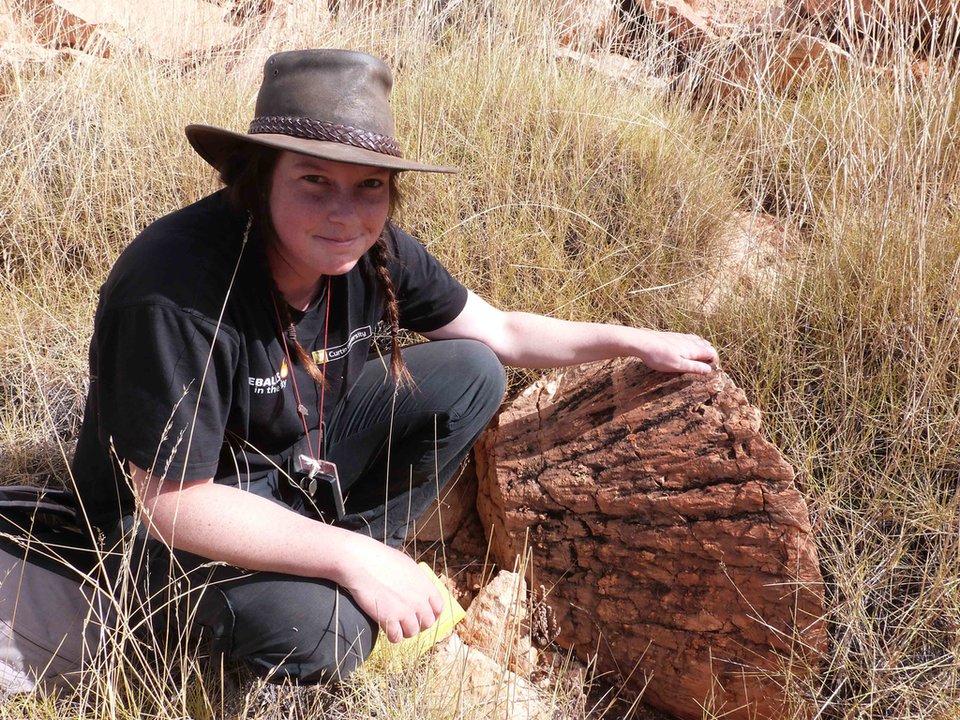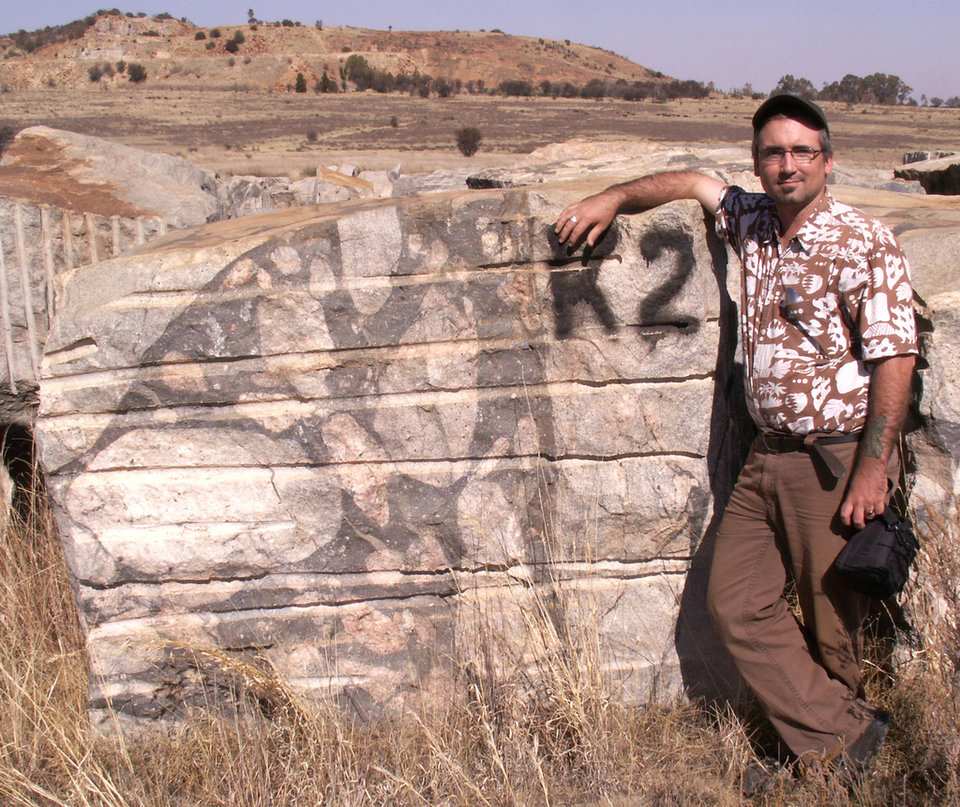Mining the world’s rarest mineral in meteor craters
An ultra-rare mineral named reidite has been found in what is possibly the world’s largest crater in Western Australia. The crater is only the sixth-known to hold the mineral, which starts as zircon before transforming to reidite under intense pressure. Molly Lempriere finds out more
Scroll down to read the article
Around 360 million years ago, in what is now Western Australia, a meteorite crashed to Earth, creating a crater some 120km wide. Now known as the Woodleigh crater, it sits in Shark Bay and is potentially the biggest crater in the world.
Despite geological examination in the 1990s and 2000s, the incredibly rare mineral reidite was discovered just last year in Woodleigh. This is only the sixth time it has ever been discovered on Earth, as it requires very exacting circumstances to be created, and it is rarely looked for.
“Reidite is so rare that one doesn’t ‘set out’ to look for it – the chances of finding it are slim,” explains Aaron Cavosie, Curtin’s School of Earth and Planetary Sciences research supervisor. “One of my Honours students, Ms. Morgan Cox, decided that it was worth it to take a look at zircon grains in the Woodleigh core, and so we requested core samples to study. We were expecting just to find damaged zircons, not reidite. Finding reidite really blew our hair back – it was a serendipitous find.”
Morgan A. Cox, an undergraduate Honours student at Curtin University, next to a shattercone at the Gosses Bluff impact crater in central Australia.

An accidental discovery
Given the length of time between the impact and current studies, it is hard to understand the full impact of the meteorite that caused the Woodleigh crater.
“The time period is called the Devonian, and Earth was quite different back then,” says Cavosie. “Plants had just started to colonise land surfaces, and sharks ruled the seas. The impact could have caused giant tsunamis if it hit in a shallow marine environment. If it hit entirely on land, it could have caused global climate shifts.”
The impact was so powerful it changed the landscape and the geology, creating reidite out of zircon, which is commonly found across the world. It is an alteration that could not happen without a meteorite.
“Impact events create crushing pressures in Earth’s surface that do not naturally occur under any other circumstance,” says Cavosie. “The pressures to form reidite – 300,000 atm of pressure, or ~30 Gigapascals – cause the atoms in zircon to re-arrange into a tighter arrangement. Imagine having a packed room full off 25 people, and then suddenly shoving 25 more people in the same room – they are packed in a lot closer together. This is what happens to the atoms in zircon – this process causes it to recrystallize into the high-pressure mineral reidite.”
In 1999, investigatory work began on the Woodleigh crater by the Geological Survey of Western Australia. It drilled into the rock examining, amongst other things, the shock metamorphism of minerals. At the time however, given its rarity, reidite was not looked for and studies stopped after just a few years.
“Reidite has only been found from six impact structures on Earth, and Woodleigh represents the first time it has been found in Australia,” says Cavosie. “All of the naturally occurring reidite that has ever been reported could probably fit under your thumbnail, so there isn’t that much.”
A controversy arose over the size of the crater during these studies, eventually drawing attention to other aspects such as minerology. “One camp interpreted the data to mean the structure was ~40km-60 km in diameter, the other favoured a size of ~120km diameter,” says Cavosie. “In other words, there was a big disagreement among the early researchers.”
“Our find of reidite, and its occurrence in the lower section of the drill core, supports the interpretation that the crater was larger than 100km,” he adds.
The impact was so powerful it changed the landscape and the geology, creating reidite out of zircon

Aaron J. Cavosie, Senior Research Fellow at Curtin University, next to a quarried block of impact-melt breccia at the giant Vredefort impact structure in South Africa.
Large impact craters in South Africa and Canada are mined for gold and nickel, but reidite is probably not economic enough
Image of shocked gneiss in drill core from the central uplift of the Woodleigh impact structure in Western Australia. The rare mineral reidite and other shock-damaged minerals were found throughout the core.

Large impact craters in South Africa and Canada are mined for gold and nickel, but reidite is probably not economic enough
Could meteor sites be mined?
While the discovery of reidite is interesting and important from a geological point of view, how practically useful it is, is another question. This is partly due to the incredibly small amount of what has been found and the difficulties of creating synthetic reidite.
“It has been synthesised in the laboratory using different types of high-pressure instruments, but it’s not easy to make in bulk,” says Cavosie. “Much is known about the crystal structure, but there are other things to explore, such as if it can be used to date impact events. We’re working on this, but it’s tricky, given the limited material.”
Both when it naturally occurs due to extreme pressure caused by meteors and when synthetically created, the base of reidite is zircon. This is a gemstone that occurs in a number of colours and has been popular predominantly for decorative purposes for 2,000 years. It is also the primary ore used to make Zirconium, which is added to metals to make them heat and corrosion resistant.
“Reidite is 10% denser than zircon, and so it has a high specific gravity,” says Cavosie. “Zirconium is used as a refractory, and reidite has the same chemical composition as zircon, so in principle, there could be material applications.”
Therefore, reidite could be used for many of the purposes that zircon currently is. It is also technically possible to mine within craters, and there are operations around the world currently taking advantage of the mineral wealth within these sites. However, it is unlikely that reidite will ever be commercially mined, in Woodleigh crater or elsewhere, due to its scarcity.
“Large impact craters in South Africa and Canada are mined for gold and nickel, but reidite is probably not economic enough and in a high enough abundance to represent a target worth pursuing, unless someone discovers something special about it,” says Cavosie.
But the importance of the discovery goes beyond mining prospects, giving us a glimpse into history, mineralogy and Earth’s relationship with space.
“Reidite is incredibly rare, and when it is found it is always associated with a cataclysm from space,” says Cavosie. “In principle it could occur in Earth’s mantle, however many zircons have been recovered from the mantle and reidite has never been reported. So when it is found, it symbolises violence from space.
“Some impact events are minor occurrences, whereas others have profound implications for life, such as the impact in Mexico 65 million years ago, that resulted in the extinction of the dinosaurs, and the rise of mammals (us!). That’s a big deal.”
A time for communication
Ukrainian state mines currently employ 51,000 workers, and are the main source of employment in regions such as the Donetsk coal basin. Mine closures over the last few years have already decimated towns and the government does not desire to close more but there is little clarity on how to progress in a profitable and sustainable way.
“The development of state-owned mines is possible in a stable environment, but wages must be paid on time,” said Trade Union of Coal Industry Workers of Ukraine deputy chair Valery Mamchenko. “Last year, UAH2.8bn ($100m) was allocated for the development of the coal industry, including the wage fund, but this year the amount is less than half.”
Without communication with unions and workers, many fear that Ukraine’s coal mining industry will remain stuck in its cycle of non-payment, protests and emergency measures. “It is essential to pay wage arrears in full; stamp out corruption in the industry; appoint managers of enterprises and mines on merit alone; and establish an effective social dialogue with trade unions,” said the Independent Trade Union of Miners of Ukraine president Mychailo Volynets.
The next few years will determine the future of Ukraine’s mining industry; now is the time for the government to focus on and support coal communities. Whether or not mining is to continue to play an important part in Ukraine’s economy and the lives of its citizens, or if it is time for the subsidies to be reduced and new energy industries to be grown, a plan must be made.
Ukrainian state mines currently employ 51,000 workers, and are the main source of employment in regions such as the Donetsk coal basin. Mine closures over the last few years have already decimated towns and the government does not desire to close more but there is little clarity on how to progress in a profitable and sustainable way.
“The development of state-owned mines is possible in a stable environment, but wages must be paid on time,” said Trade Union of Coal Industry Workers of Ukraine deputy chair Valery Mamchenko. “Last year, UAH2.8bn ($100m) was allocated for the development of the coal industry, including the wage fund, but this year the amount is less than half.”
Without communication with unions and workers, many fear that Ukraine’s coal mining industry will remain stuck in its cycle of non-payment, protests and emergency measures. “It is essential to pay wage arrears in full; stamp out corruption in the industry; appoint managers of enterprises and mines on merit alone; and establish an effective social dialogue with trade unions,” said the Independent Trade Union of Miners of Ukraine president Mychailo Volynets.
The next few years will determine the future of Ukraine’s mining industry; now is the time for the government to focus on and support coal communities. Whether or not mining is to continue to play an important part in Ukraine’s economy and the lives of its citizens, or if it is time for the subsidies to be reduced and new energy industries to be grown, a plan must be made.
It is essential to pay wage arrears in full [and] stamp out corruption in the industry